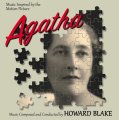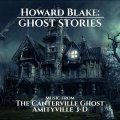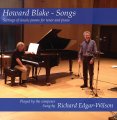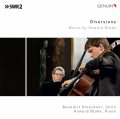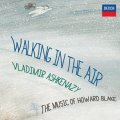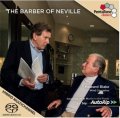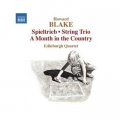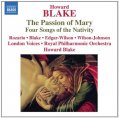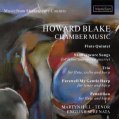 Highbridge Music Ltd.
Highbridge Music Ltd.
Studio 6, 18 Kensington Court Place, London W8 5BJ, UK
Email: howard@howardblake.com
Recordings
Details of published CD, DVD, Video and LP recordings of the works of Howard Blake.
Use the search form to filter results, search by keyword, title, artists or related opus number.
A full list of all of Howard's works which have been recorded (though not necessarily published or made available for sale) can be found here.
Walking in the Air - Vladimir Ashkenazy - The piano music of Howard Blake (CD)
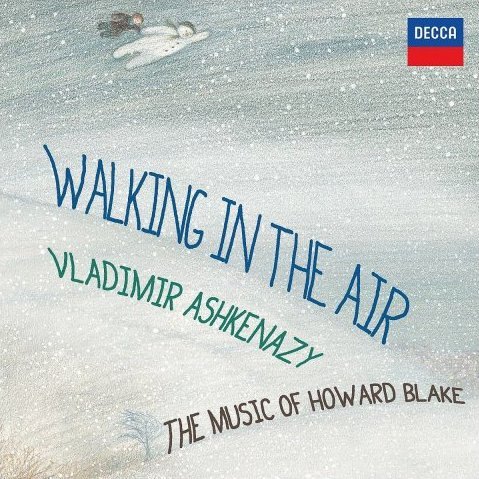 Released: 3rd March 2014
Released: 3rd March 2014Recorded: June 2013
Artists: Vladimir Ashkenazy (piano) Vovka Ashkenazy (piano)
Categories: [Film & TV Scores] [Piano] [Two-piano]
Available from:
Released by: Decca Classics
Decca Classics
Beaumont House,
Avonmore Road,
Kensington Village,
Kensington,
London,
W14 8TS
UK
Beaumont House,
Avonmore Road,
Kensington Village,
Kensington,
London,
W14 8TS
UK
And the Snowman came too - piano music by Howard Blake played by Vladimir Ashkenazy
Labels:
cd review
Walking in the Air - piano music by Howard Blake: Vladimir Ashkenazy, Vovka Ashkenazy: Decca
Reviewed by Robert Hugill on Apr 24 2014
Star rating:
Fine survey of Blake's piano music covering his entire career
This new disc of piano music by Howard Blake on Decca could be seen as a survey of the composer's varied career as it not only includes recent music (his Parting, op.650a from 2013 ) and his opus 1, but also a works from different periods in his career including a group of items based on his film scores and notably, a piano piece based on Blake's most famous piece of music Walking in the Air from The Snowman. Here the music is played by the distinguished pianist Vladimir Ashkenazy (joined by his son Vovka Ashkenazy for the works for two pianists).
Reviewed by Robert Hugill on Apr 24 2014
Star rating:
Fine survey of Blake's piano music covering his entire career
This new disc of piano music by Howard Blake on Decca could be seen as a survey of the composer's varied career as it not only includes recent music (his Parting, op.650a from 2013 ) and his opus 1, but also a works from different periods in his career including a group of items based on his film scores and notably, a piano piece based on Blake's most famous piece of music Walking in the Air from The Snowman. Here the music is played by the distinguished pianist Vladimir Ashkenazy (joined by his son Vovka Ashkenazy for the works for two pianists).
Blake trained at the Royal Academy of Music in the 1950's studying with Howard Ferguson and finding his style of composing did not fit with the prevailing modernist ethos. He had great success as a conductor and composer going into films, but in the 1970's he turned his back on this and re-worked his style to develop his pure classical music again. As a composer Blake has never turned his back on any of his music, he has the admirable ability to incorporate the different facets of his career into one seamless whole and this disc reflects that.
The disc opens with an arrangement for solo piano of Walking in the Air from the 1982 animated film The Snowman. It makes a lovely piano prelude, with Blake working the famous tune into an attractive pianistic texture. Music from the 1979 film The Changeling follows; Music Box is based on a theme written originally for a music box but developed here into a fluently attractive piece. It is not just about the big tune, as there is also plenty of finely crafted piano writing to enjoy. The final piece of film music is Laura from the 1977 film The Duellists which is a more darkly sombre character piece.
The Prelude for Vova was commissioned in 2012 by Vladimir Ashkenazy (the Vova of the title) and the intention was to make a piece out of his initials, and Blake uses A-S-H (A, A flat, B natural) as the basis for this melancholy character piece whose initial restlessness develops into something quite strenuous. Speech after Long Silence was written at Ashkenazy's instigation for the 2011 Hong Kong International Piano Competition. As the name suggests, it starts from a quietly atmospheric opening and develops into something bigger. At nearly eight minutes this is one of the longest single pieces on the disc and is an impressively large-scale composition, far more complex and more full of pianistic drama than the character pieces.
The Eight Character Pieces were written in 1975, again for Vladimir Ashkenazy. The eight movements follow key sequence with pairs of minor and major in a series of descending fifths, B minor, B major, E minor, E major so that the cycle ends in D major (rather neatly the relative major of B minor). A lyrically melodic Prelude leads a wistful but muscular Nocturne. The Impromptu is flowing but with a busy texture underneath (hints of Michael Nyman here, though the piece was written 18 years before Nyman score The Piano), whilst the Toccatina is a playful toccata. Mazurka has interesting rhythmic elements though I doubt you could dance to it, and the lyrical Walking song has a steady onward feel to it. Chaconne has some big dramatic piano writing over the constantly moving bass, whilst the concluding Scherzo skitters about jazz style (Blake calls it Oscar Peterson-inspired).
Dances for Two Pianos was written in 1976, again we have a sequence of short movements (nine in all), each in a different dance style but as with other Blake pieces in this genre there are mischievous differences (the rhumba seven in a bar for instance) and the use of two pianos enables Blake to give us some richly imaginative textures. The work opens with the Rhumba full of delight and humour, then a Slow Ragtime which is all relaxed charm. Jump is all complex rhythms with fast accented offbeats, whilst Medium Rock is very laid back. Folk Ballad starts gentle and spare, before developing into something more complex. Boogie is a mad, up tempo jazz piece with an infectious rhythmic swing, the Jazz Waltz has a lovely melody with hints of Bill Evans, given a not uncomplicated treatment. Cha Cha is fun but not too fast, and the suite finished with a completely mad Galop.
Blake's Sonata for Two Piano dates from the early 1970's, in four movements it is perhaps one of the most serious pieces on the disc, definitely not programmatic nor a character piece. The opening Allegro has some strenuous writing for the pianists, with lovely big chords, and a low key end. The quiet and spare Lento is more chromatic and less tonal than some of the music on the disc and I started to think of Bartok here. The spiky yet infectious Scherzando is playful and skittering with jazzy rhythms and 'wrong' notes'. Finally a Presto which is brisk and upfront, with the two players playing the complex textures with verve.
Piano Fantasy is Blake's opus 1 dating from 1955 when the composer was 16. In it, the young composer explores oppositions of mood and texture, quiet v. loud, spare v. busy and there are some positively orgasmic climaxes. The Four Easy Pieces (from 1956) are simple but effective, quite folk-influences with spare textures. Next comes a Romana from 1963 written as a result of Blake's first meeting with Vladimir Ashkenazy (whose wife was at the Royal Academy of Music with Blake). It is a complex, romantic piece with rich harmonies.
The disc finished with a pair of recent works. Haiku for Yu-Chee a lovely spare piece from 2006 written for his next door neighbour, and finally Parting a lovely little piano miniature written specially for the disc.
Throughout, Vladimir Ashkenazy's playing is exemplary and he brings out the charm of the smaller pieces and rhythmic joy of the smaller pieces, whilst taking the bigger, more taxing ones in his stride. With his son Vovka, the two make a fine piano duo.
This lovely disc wends its way round both Howard Blake's career and his relationship with pianist Vladimir Ashkenazy, resulting in a highly personal selection of pieces. It is also great fun to listen to and to dip into.
Related Opuses
- op.0001b *PIANO FANTASY (August 1955)
- op.0001d *FOUR EASY PIECES (November 1956)
- op.0130 *SONATA FOR TWO PIANOS (June 1971)
- op.0247 *THE DUELLISTS (March 1977)
- op.0274 *THE CHANGELING (January 1979)
- op.0610 *SPEECH AFTER LONG SILENCE (February 2010)
- op.0310 *THE SNOWMAN (ANIMATED CHILDREN'S FILM) (September 1982)
- op.0640 *PRELUDE FOR VOVA (April 2012)
- op.0217a DANCES FOR TWO PIANOS (four-stave version) (1976)
- op.0650a *PARTING (May 2013)
Tracks
- 1) Walking in the Air - opus 489u - 3:07
- 2) Music Box - opus 489n - 3:53
- 3) Laura - opus 604 - 2:01
- 4) Prelude for Vova - opus 640 - 3:02
- 5) Speech After Long Silence - opus 610 - 7:56
- 6) Eight Character Pieces - 1
- 7) Eight Character Pieces - 2
- 8) Eight Character Pieces - 3
- 9) Eight Character Pieces - 4
- 10) Eight Character Pieces - 5
- 11) Eight Character Pieces - 6
- 12) Eight Character Pieces - 7
- 13) Eight Character Pieces - 8
- 14) Dances for two pianos - 1 - opus 217a
- 15) Dances for two pianos - 2 - opus 217a
- 16) Dances for two pianos - 3 - opus 217a
- 17) Dances for two pianos - 4 - opus 217a
- 18) Dances for two pianos - 5 - opus 217a
- 19) Dances for two pianos - 6 - opus 217a
- 20) Dances for two pianos - 7 - opus 217a
- 21) Dances for two pianos - 8 - opus 217a
- 22) Dances for two pianos - 9 - opus 217a
- 23) Sonata for two pianos - 1 - opus 130
- 24) Sonata for two pianos - 2 - opus 130
- 25) Sonata for two pianos - 3 - opus 130
- 26) Sonata for two pianos - 4 - opus 130
- 27) Piano Fantasy - opus 1 - 4:20
- 28) Four Easy Pieces - opus 1b - 3:40
- 29) Romanza - opus 489o - 2:26
- 30) Haiku for Yu-Chee - opus 567 - 1:12
- 31) Parting - opus 650a - 1:21
Reviews
by Straits Times 10/2014CD Reviews (The Straits Times, October 2014)
WALKING IN THE AIR
The Music of Howard Blake
VLADIMIR ASHKENAZY, Piano
Decca 478 6300 / ****1/2
For all the prolific output of British composer Howard Blake (born 1938), over 650 works to date, he will forever be remembered for Walking In The Air, that mega-hit song in the children’s animated Christmas film The Snowman. Its simplicity and beauty permeates most of this album of Blake’s piano music which spans from 1955 to 2013, performed no less by his close friend Vladimir Ashkenazy. The piano version of Walking, which falls easily within the hands of young pianists, is now part of Lifecycle. This suite of 24 short pieces or preludes also includes Eight Character Pieces (1975), Music Box from the movie The Changeling (1979) and the early Russian-flavoured Romanza (1963), written for the Ashkenazys after their defection to the West.
Blake’s Sonata (1971) and Dances (1976) for two pianos (with Ashkenazy’s eldest son Vovka on second piano) deserve to be better known, the latter being a set of variations on a simple theme in a panoply of dance styles, including waltz, ragtime, boogie-woogie and cha-cha. The major single-movement work in this set is Speech After Long Silence (2011), written as a set-piece for the Hong Kong International Piano Competition. This is an alternatingly brooding and ecstatic essay in the manner of Rachmaninov, which perfectly suits the temperament of Russian virtuoso. An enjoyable listen, from start to end.
Walking in the Air: VLADIMIR ASHKENAZY PLAYS THE PIANO MUSIC OF HOWARD BLAKE
Reviewed by: Robert Matthew-Walker Howard Blake The Snowman – Walking in the Air, Op.489u The Changeling – Music Box, Op.489 The Duellists – Laura, Op.604 Prelude for Vova, Op.540 Speech After Long Silence, Op.610 Eight Character Pieces, Op.338 Dances for Two Pianos, Op.217a* Sonata for Two Pianos, Op.130* Piano Fantasy, Op.1 Three Easy Pieces, Op.1b Romanza, Op.489o Haiku for Yu-Che, Op.567 Parting, Op.650a Vladimir Ashkenazy & *Vovka Ashkenazy (pianos) Recorded March & June 2013 in Potton Hall, Dunwich, Suffolk, England CD Number DECCA CLASSICS 478 6300 Duration 81 minutes Review Date June 2014 Whence inspiration? The extraordinary, vital spark of artistic creativity – that which sets the artist off on a new journey of creation – from where does it come? Clearly, from within the mind (or so the interested observer will believe), but some aspect or combination of circumstances must surely exist at the moment an idea pops into the head as the composer might say. On walking down the road, we all might hum a tune to ourselves, and with little else to engage us perhaps our brain’s musical area might bring to mind a melody matching our mood and the tempo of our walking-pace: eighty years ago, Constant Lambert wrote of “the appalling popularity of music”, citing the sounds coming from the open windows of adjoining houses with their radios on, accompanying the town-dweller out for a stroll, each step on the paving stone coinciding with a bar of music. It’s probably as true today as it was then, although it’s more the mobile phone that carries the music to us (and others!), but without that outside stimulus Lambert’s notion of music accompanying our daily walk still holds good, even if we might wonder what tunes came unbidden into Karlheinz Stockhausen’s mind as he negotiated the winding Bergstrasse in Kürten, such a concept perhaps needing a greater leap of the imagination than most people possess. It’s probably truer to say that musical people from any cultural background (and we don’t have to define ‘musical’ people, do we? – for Hans Keller, such people are those who need to experience music frequently, as an important part of their lives, not those who take it or leave it) are those who probably are more prone to hum tunes to themselves, but if the comfort zones of today’s commuters, as exemplified through their personal earpieces, replace such spontaneous creative experiences with the reassurance of music they know already, then that creative area of the brain might wither and die through atrophy. Howard Blake. Photograph: Tim Motion After all, you cannot think of one tune if another is being fed into your brain. It may be possible, but it’s surely more difficult. So if you’re walking your dog in the park and, suddenly, unbidden, a tune comes into your conscious mind – one that you’ve never heard before and which catches your imagination – such an experience, surely, is a moment of inspiration. Tchaikovsky would enter his study each morning at 9 o’clock to begin writing music – composing, copying or revising an existing work, or orchestrating another, or whatever: keeping the brain’s channels of communication open for when his inspiration called. As he said: “My muse knows to contact me at that hour” (or something similar), but not every composer is as regular in those habits as was Tchaikovsky – although Britten, it seems, possessed a similar work ethic. Inspiration can strike at any time: Elgar asked his driver Dick for the Ordnance Survey map in the car to scribble down the opening of the Fifth Pomp and Circumstance March which had suddenly come to him when they were out for a drive, and Stravinsky is known to have used a restaurant menu for a similar purpose. The important thing, surely, is to capture that inspiration on paper, or at least in some permanent form, before it disappears; Turner carried a sketchpad for the same reason, and there must be very many instances of artists, in whichever medium, being desperately keen to capture that moment. Not all composers have permanent memories for such ideas, but Howard Blake has – and we may imagine he thanked his lucky stars one sunny day when, out walking his dog, a tune arrived in his mind. This was in the early 1970s, soon after Blake (born 1938) had resolved to abandon the constant pressures of composing commercial music to order, often at a few days’ notice, which had consumed his working life for a good many years. At first, he was not quite sure what to do with the tune, although he knew it was a good one. Years later, in 1982 in fact, he realised it ideally fitted a Channel 4 animated film of Raymond Briggs’s picture-book story, The Snowman. It soon became a hit, not only in countries where the film was shown; it has been televised every Christmas since; the CBS Masterworks album went platinum; the EMI single, sung by the young Aled Jones, reached the top of the singles chart, and the two-act ballet version has been staged by Sadler’s Wells in London for fifteen years running, becoming as much a part of Christmas as Tchaikovsky’s The Nutcracker. Seeing The Snowman at London’s Peacock Theatre over a dozen years ago, I described the ballet in Musical Opinion as a “masterpiece” – as a stage show, it certainly is, and remains so: the following year, I took my three-year-old granddaughter to see it, and she sat entranced. Vladimir Ashkenazy. Photograph: Keith Saunders ‘Walking in the air’ may have brought Howard Blake fame, and financial stability, but such is the nature of today’s compartmentalisation of what an artist can or cannot do, or what they ought or ought not to be doing, that society nowadays appears to have taken the view that, once tagged with a particular label (rightly or wrongly), a composer cannot be perceived to be just as good in another area, and if they venture to do so, a part of the critical fraternity has to put them in their place. Quite why this should be so may tell us more about the critics than about the artists involved. In recent decades we have seen a type of ‘cross-over’ from pop and rock to what might be broadly termed ‘classical’, yet perhaps it was always thus: ‘popularity’ does not – indeed, cannot – always equate with artistic inferiority, and ‘ivory-tower’ modern composers are not ‘better’ than popular ones simply because their music does not conform to the familiar or customary. It may take a while to remove such blinkered attitudes, for as Schoenberg said: “A Chinese philosopher speaks Chinese: the question is, ‘what is he saying?’”, and whilst we don’t necessarily have to agree with Leonard Bernstein’s statement that “I prefer great rock ‘n’ roll to bad Beethoven” (pity no-one asked him for chapter and verse), the fact that Sir William Glock gave Soft Machine the first-ever late-night BBC Prom in 1970, indicated a breadth of – at least – musical curiosity, if not acceptance, that we would do well to emulate. For Howard Blake, composition has been pretty much a compulsion for most of his life: “I had a local piano teacher, and I’d make up tunes for my family at Christmas and birthdays. Nobody told me to do it, I just wrote tunes, and when I was about eleven, I wrote a march and took it to my teacher who asked, ‘Where did this come from?’. “I wrote it”. At first he didn’t believe me. But he realised I was serious, and took me through all of Kitson’s harmony and counterpoint books. I loved it.” From then on, Blake knew he liked writing music more than anything, although his father “would not have entertained the idea that I could become a musician”. His mother was musical and played the piano and violin very well. “She encouraged me, and through her I started the piano. I worked hard ... getting Grade VIII with distinction. The Hastings Festival – the only Southern England festival offering a Royal Academy of Music scholarship – was the first time I entered any competition. I went in for the Bach Prize, the Beethoven Prize, the Chopin Prize and the Academy Scholarship Prize – and I won all four. Although I thought I might make a concert pianist, I still wrote music, but nobody encouraged me much. At the Academy I chose organ as a second subject, but during the interview the subject got round to harmony, and I was told to bring in some original work. I brought a four-movement orchestral suite, and they said, ‘Shouldn’t you be studying composition?’. It had never occurred to me!” And so Blake became a composition student of Howard Ferguson. There are few living composers who possess the combination of fluency, technical ability and melodic inspiration as Howard Blake does, so when such a greatly distinguished artist as Vladimir Ashkenazy makes a recording of his piano music, on which he has his son Vovka partner him in works for two pianos, we would do well to abandon any prejudices we might harbour and listen. The recital opens with ‘Walking in the air’; that simple tune, as a piano piece, continues to exert its haunting influence, and Ashkenazy’s phrasing raises it to the level of a minor masterpiece. This is followed by two other pieces, originally used as part of film scores: ‘Music Box’ from The Changeling (the 1980 horror movie, starring George C. Scott as a bereaved concert pianist), and ‘Laura’ from The Duellists (Harvey Keitel and Keith Carradine), a score which won the Special Jury Prize at the 1981 Cannes Film Festival. These two short concert studies (for, divorced from the screen, that is what they are) are given with much refinement by Ashkenazy, as does the succeeding item, Prelude for Vova (Vladimir Ashkenazy himself). The unusually entitled Speech After a Long Silence was also requested by Ashkenazy, an eight-minute test piece written for the 2011 Hong Kong International Piano Competition, played by each competitor in round four of the competition. Blake has said that Ashkenazy’s performance is “finer than I could have dreamed of”. In structural terms, the one composer it brings to mind is Sibelius. The Eight Character Pieces were also suggested by Ashkenazy, in 1975, following what Blake describes as “an extraordinarily brilliant Scriabin recital at the Queen Elizabeth Hall”. The work overall (22 minutes) is a late-20th-century Carnaval (the third – and longest – piece, ‘Impromptu’, is a truly fine example of Blake’s idiomatic writing, as well as being superbly expressive). The Character Pieces were eventually incorporated into Blake’s Lifecycle of 1995 (24 pieces, each in a different key), but the work in its original form makes a perfectly satisfying and coherent composition. Two very different pieces for two pianos follow: nine comparatively brief Dances, almost forming a collection of ‘encores’ in lighter style, succeeded by a major work by any standards, Sonata for Two Pianos (1971) in four movements, which in the finale demands (and gets here) considerable virtuosity from both players. Then comes a group of very early solo pieces: Fantasy, composed in 1955 at the age of sixteen (“rediscovered for this album”), a simple broad ABA structure, declares his natural compositional gifts in no uncertain manner, and Four Easy Pieces from the following year (written as a birthday present for a girlfriend, who apparently turned both composer and his music down), but delightful miniatures. Vladimir Ashkenazy reveals all there is to be found in these early pieces, and this excellently recorded recital continues with Romanza, inscribed to the pianist (and his wife), another extremely beautiful piece, based upon early material – a succinct morceau de fantasie, perhaps. The programme ends with two items, just 70 and 80 seconds in duration respectively, and perhaps the most personal of Blake’s piano pieces to appear in recent years. They form a fitting addendum to a recital of eminently worthwhile music by a composer whose more-serious works – in particular his concertos – manifestly deserve to be heard more frequently. It is a pity, though, that Decca’s presentation is poorly packaged, for nowhere on the front cover is the word “piano” given – Ashkenazy might be conducting Blake’s orchestral music; the layout is childishly feeble, and omitting Vovka’s name from the cover is a deplorable oversight. The opus number of the Eight Character Pieces is also omitted. It is worth mentioning that Sir Neville Marriner and the Academy of St Martin-in-the-Fields are to give a concert devoted to Howard Blake’s music on November 25 at the eponymous London church, including the world premiere of a work for double string orchestra, the melodic inspiration of which will not be hard to seek. Decca Classics
04.03.2014
Vladimir Ashkenazy
Von Freund zu Freund - Vladimir Ashkenazy spielt Klaviermusik von Howard Blake
Vladimir Ashkenazy widmet sein neues Album "Walking in the Air" der Musik des britischen Komponisten Howard Blake. Die Musiker verbindet eine langjährige Freundschaft. Für beide ging mit dem Album ein lang gehegter Wunsch in Erfüllung.
© Ben Ealovega / Decca Vladimir Ashkenazy
Der Pianist Vladimir Ashkenazy macht seit einem halben Jahrhundert als Exklusivkünstler Aufnahmen für das Label Decca und hat fast jede Facette der klassischen Klavierliteratur beleuchet. Mit seinem neuen Album beweist er, dass er nach wie vor für Überraschungen gut ist: "Walking in the Air" ist seine Hommage an den britischen Komponisten Howard Blake. Nicht weniger als neun Weltersteinspielungen beinhaltet diese Werkschau, in deren Verlauf der große Pianist das Schaffen von Howard Blake erkundet, von frühen Kompositionen aus den 1950er Jahren über Klavierstücke für Ashkenazy aus den 1970ern bis in die Gegenwart.
Längst überfällig
Vladimir Ashkenazy betrachtet sein neues Album als längst überfälliges Geschenk für den Komponisten, der im Oktober 2013 seinen 75. Geburtstag gefeiert hat. „Ich kenne Howard Blake seit über 40 Jahren und denke gern an seine vielen Besuche in meinen Konzerten und Recitals zurück“, sagt er. „Zu erfahren, dass mir Howard einige seiner Klavierstücke gewidmet hat, schmeichelte mir außerordentlich. Seither hegte ich den Wunsch, sie aufzunehmen. Es hat zwar etwas länger gedauert als geplant, doch ich bin sehr glücklich, nun endlich ein ganzes Album mit seiner Musik vorzustellen.“
Riesiges Œuvre
Howard Blake hat im Verlauf seiner über 50-jährigen Laufbahn mehr als 650 klassische und populäre Werke komponiert. Mit Unterstützung des legendären Bernard Herrmann gelang es ihm, sich in den 1970er Jahren als gefragter Filmkomponist zu etablieren. Aus seiner Feder stammen unter anderem die Soundtracks für Ridley Scotts "The Duellists" und Mikes Hodges' "Flash Gordon". Mit der Filmmusik für den Zeichentrickfilm "The Snowman" und dem darin enthaltenen Stück "Walking in the Air" feierte Howard Blake 1982 den größten Erfolg seiner Karriere. Sein Klavierkonzert zum 30. Geburtstag von Prinzessin Diana, an dessen Uraufführung im Jahr 1991 er als Solist mitwirkte, verhalf ihm zu noch größerer Popularität. 1994 wurde Blake mit dem Order of the British Empire für besondere musikalische Verdienste geehrt.
Tiefe Verbundenheit
Neben einer Auswahl von Howard Blakes bekanntesten Filmmelodien, wie "Laura" aus "The Duellists" und "Music Box" aus dem Horror-Klassiker "The Changeling", beinhaltet das Album auch eine Reihe jüngerer Werke, die Vladimir Ashkenazy in Auftrag gegeben hat. Eines davon ist das "Prelude for Vova" (op.640). In diesem 2012 komponierten Konzertstück, das von Liszts „Präludium und Fuge über den Namen BACH“ inspiriert ist, verwendet Blake anstelle von B-A-C-H die Notenfolge A-(E)S-H als Zeichen seiner Verbundenheit mit dem Pianisten. Ebenfalls im Auftrag Ashkenazys entstand das letzte Stück des Albums "Parting" (op.650a), in dem Blake die langjährige Freundschaft in ergreifender Weise verarbeitet. Die beiden Werke für zwei Klaviere (opp.217a und 130) hat Vladimir Ashkenazy zusammen mit seinem Sohn Vovka eingespielt.
„Seine Klaviermusik ist extrem gut geschrieben und pianistisch, was natürlich daran liegt, dass er selbst ein sehr guter Pianist ist. Darum macht es mir große Freude, sie zu spielen“, erklärt Vladimir Ashkenazy. „Mit diesem Album geht für mich ein Lebenstraum in Erfüllung“, sagt Howard Blake, „und Vovas Interpretationen der Werke sind noch schöner, als ich mir je hätte erträumen können.“
A fine collection of piano works by Howard Blake receives terrific performances from Vladimir and Vovka Ashkenazy on a new release from Decca
Howard Blake www.howardblake.com (b. 1938) is best known for his music for the 1982 film The Snowman that includes the song Walking In The Air. Yet his compositions include concertos, oratorios, ballets, operas and many instrumental works.
Blake was born in London but grew up in Brighton, Sussex. Whilst attending Brighton, Hove and Sussex Grammar School for boys he sang lead parts in Gilbert and Sullivan operettas and was recognised as a talented pianist. At the age of 18 years Blake won a scholarship to the Royal Academy of Music to study piano with Harold Craxton and composition with Howard Ferguson. Finding himself at odds with his contemporaries concerning musical style he virtually stopped composing, turning his attention to film.
On leaving the RAM he briefly worked as a film projectionist at the National Film Theatre before playing piano in pubs and clubs for a period of time. Working as a session musician on many recordings led his to work as an arranger and a composer, a role which gradually became his full-time occupation
Blake has written numerous film scores, including The Duellists with Sir Ridley Scott and David Puttnam, which gained the Special Jury Award at the Cannes Festival in 1977, A Month in the Country with Kenneth Branagh and Colin Firth which gained him the British Film Institute Anthony Asquith Award for musical excellence in 1989, and, of course, The Snowman, which was nominated for an Oscar.
Blake’s concert works include a piano concerto commissioned by the Philharmonia Orchestra for the 30th birthday of Princess Diana in 1991, a violin concerto to celebrate the centenary of the City of Leeds in 1993, a cantata to celebrate the 50th Anniversary of the United Nations in 1995 and the large-scale choral/orchestral work, Benedictus (1980).
More recent works include Lifecycle – Twenty four pieces for solo piano (2003), Songs of Truth and Glory (2005), commissioned for the Three Choirs Festival, The Land of Counterpane (2007) a song-cycle to words by Robert Louis Stevenson.
Howard Blake is a Fellow of the Royal Academy of Music and, in 1994, received the OBE for services to music.
A new release from Decca www.deccaclassics.com , entitled Walking in the Air, features piano works by Blake performed by Vladimir Ashkenazy www.vladimirashkenazy.com and Vovka Ashkenazy http://musicalworld.com/artists/vovka-ashkenazy . The works on this disc give an excellent view of Blake’s work ranging in date from 1955 to 2013.
The title of this new release could, at first sight, be taken to indicate a collection of lightweight pieces. However, the composer of the music for The Snowman reveals himself to be a composer of substance in some terrific pieces played superbly by Ashkenazy.
What can one say about Blake’s music for The Snowman? Walking in the Air, Op.489u (1982) is a tune in a million and, as played by Vladimir Ashkenazy, has a beautiful richness of texture.There are two further film related pieces on this disc, first Music Box (from The Changeling), Op. 489n (1979) that has so many distinctive Blake features, yet with an early 20th century quality and some lovely touches from Ashkenazy. Laura (from The Duellists), Op. 604 (1977) has some surprisingly dissonant intervals that make this a very attractive piece.
Written for Vladimir Ashkenazy, Prelude for Vova, Op.640 (2012) has similar features and, though relatively short, is a work of some substance that rises to a rousing climax with terrific playing from Ashkenazy.
Speech After Long Silence, Op.610 (2011) is a haunting piece that rises to a number of climaxes with some rather difficult, quite unusual passages. When the main theme re-appears it is a terrific moment.
Eight Character Pieces (1975) opens with a Prelude: Andantino that has Blake’s distinctive rising intervals that are instantly identifiable. This is a lovely little piece. Nocturne: Andantino sounds like a tribute to Chopin with its trills and certain intervals. For all that, it is a gorgeous piece, with Ashkenazy providing all that one could want. Impromptu: Cantabile has Ashkenazy showing his incomparable technique in playing of formidable delicacy and lightness of touch. Toccatina: Vivo, an even faster piece than the Impromptu, again shows Ashkenazy’s terrific technique in this little gem that, again, has hints of Chopin.
Mazurka: Tempo di mazurka is fascinating in that, through the mazurka rhythm, one can again hear Blake’s distinctive fingerprints, those rising intervals. Walking Song: Semplice is simple, direct, yet full of character and feeling whilst the slow Chaconne in D minor: Lento has strange intervals and harmonies that slowly build in strength to a climax with superb playing from Ashkenazy particularly in the later cascading, descending passage. The final piece, Scherzo in D major: Prestissimo, hurtles forward before a slow affecting melody that is soon replaced when the prestissimo again pulls us forward at breakneck speed to a coda that returns to the slow tune.
Vladimir Ashkenazy is joined by, Vovka Ashkenazy for the Dances for Two Pianos, Op.217a (1976). Parade: Allegro is a rollicking piece, full of fun, Slow Ragtime has a lovely gentle pulse, Jump: Allegro an attractive syncopated rhythm,
Medium Rock has a nostalgic theme, still with a rhythmic pulse and in Folk Ballad: Lento Blake develops a simple folksy theme into something more substantial.
Boogie, tempo giusto is, again, great fun, full of manic humour with these pianists on fine form and enjoying themselves, Jazz Waltz is a terrific little waltz with, as the title suggests, jazz inflections, the infectious Cha-cha is given a lovely rhythmic pulse whilst the Dances conclude with a madcap Galop.
Vladimir and Vovka Ashkenazy are absolutely brilliant in this work.
The Allegro of Sonata for two pianos, Op.130 (1971) has a rather strident opening before the lines of the two pianos quieten and open out. There are many dramatic moments with some fabulous playing of great accuracy from Vladimir and Vovka Ashkenazy as well as moments of intense, nervous energy. The Lento brings some beautiful dissonances as the two pianists make their way through this haunting landscape, rising to a number of peaks before ending quietly.
There are terrific rhythms in the Scherzando that rattles ahead with each player chasing the other. In the final Presto these pianists burst out in the opening with powerful playing before a gentler section appears that doesn’t last long. This is virtuosic music that requires players of the utmost virtuosity which is exactly what it gets here. A stunning conclusion to a work that will give a surprise to anyone expecting the Howard Blake of The Snowman.
The early Piano Fantasy, Op.1 (1955) has a quiet, tranquil English atmosphere that gives way to a lively, buoyant central section before descending into the tranquillity of the opening theme. This piece is beautifully realised by Vladimir Ashkenazy. Comparing this with Blake’s later work shows that his music has lost none of his early freshness and life.
Four Easy Pieces, Op.1b (1956) has a spiky little Moderato, a gentle Valse triste that has a beautiful nostalgic feel, and a lively Con moto before the melancholy Andantino. Ashkenazy takes such care, always drawing all he can from these simple little pieces
Romanza, Op.489o (originally Op.5f) (1963) Andante con moto is a flowing piece that rises to a lovely climax. It is a beautiful piece full of atmosphere.
Haiku for Yu-Chee, Op.567 (2006) brings a halting little theme showing how Blake can draw so much from so little.
This fine collection of piano works concludes with Parting, Op.650a (2013), a brief, sad, haunting piece.
I do hope that the popularity of The Snowman will not have the opposite effect of discouraging serious collectors from trying this worthwhile and attractive disc. There are some extremely fine works here that receive terrific performances.
The recording made at Potton Hall, Suffolk, England is first class and there are excellent booklet notes by the composer
AllMusic Review by Blair Sanderson [+]
British composer Howard Blake seems to lead two careers, writing music for films and for the concert hall, yet this division is somewhat arbitrary because so much of his work has crossover appeal. The music for the 1982 film The Snowman, for example, has become one of Blake's most recognizable scores, and its signature song, Walking in the Air, has become a genuine hit, covered by pop and even heavy metal artists. Blake has also written evocative music for the films The Duellists and The Changeling, and their themes are included in this 2014 Decca release by pianist Vladimir Ashkenazy. In many instances, Blake composes in a relaxed contemporary classical style, as in the series of 24 piano pieces in Lifecycle, of which 10 are presented here, including the keyboard version of Walking in the Air. Blake is an unabashed tonalist with a pleasing lyrical gift that makes his music instantly accessible, though its mild harmonies and simple melodies are rarely challenging. However, the Dances for 2 pianos and the Sonata for 2 pianos show more rhythmically active music infused with jazz harmonies, and Ashkenazy's performances with his son, Vovka Ashkenazy, are easily the most entertaining selections of this disc.

